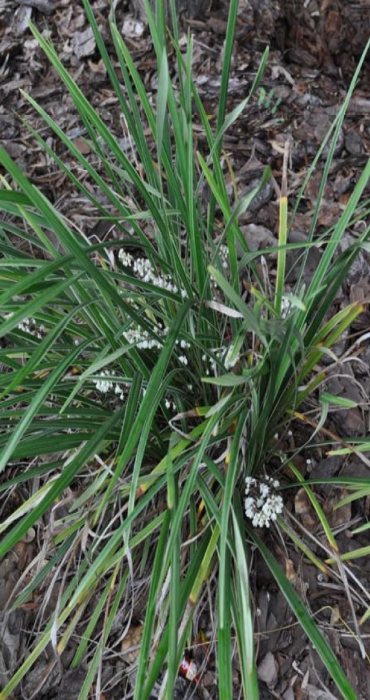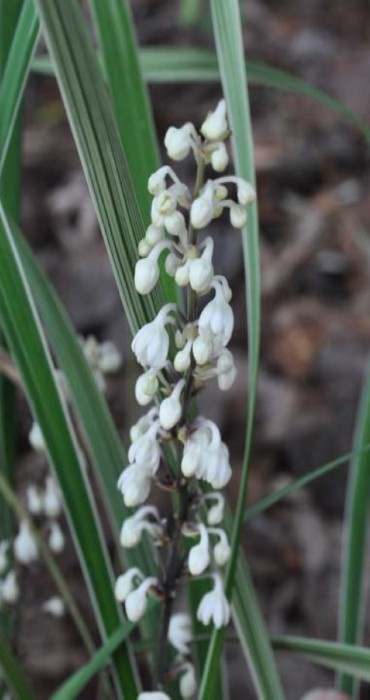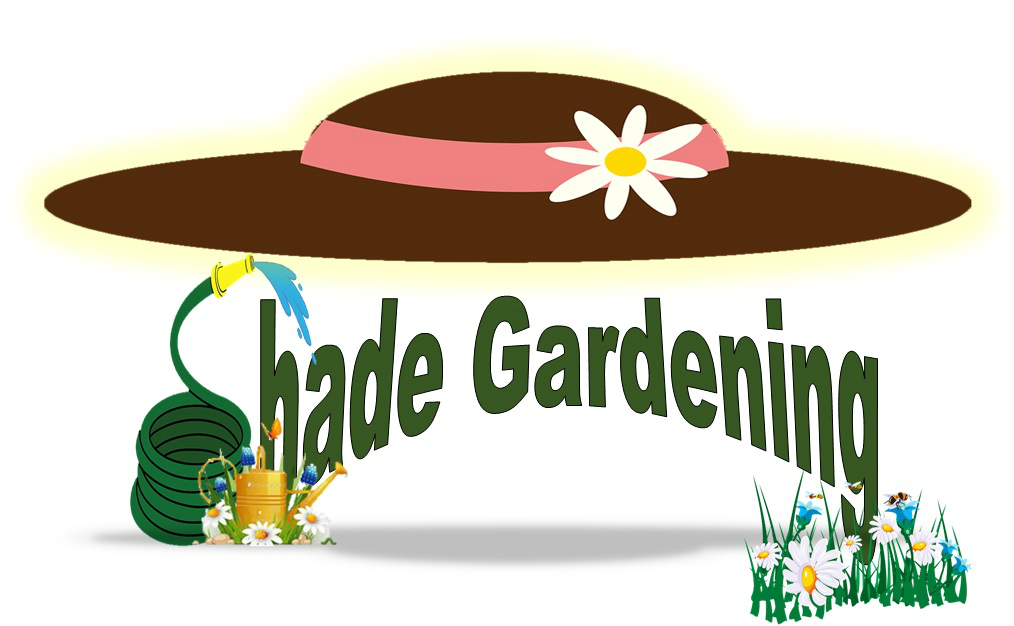Ask Master Gardener Volunteer JoAnn Green
All three of these non-native ‘grasses’ make lovely groundcovers and borders in the shady landscape. Each prefers partial shade, and a few do okay in sunnier areas. They are relatively easy to maintain, once established, and have few pest problems. While Azetc grass and liriope do have flowers in summer, it is the strap-like foliage for all three varieties that is most noticeable.
Video Credit: JoAnn Green, Wakulla County Master Gardener Volunteer
Aztec Grass

Ophiopogon intermedius is an evergreen ornamental grass that has green and white variegated leaves. The leaves are the plant’s most striking feature, adding a soft white light to darker areas in the shady garden. This plant will grow to about 2 feet tall and into clumps between 1-2 feet in diameter. Small white flowers appear on slender spikes in mid to late summer, followed by small black fruits.
Azetec grass will tolerate our sandy soil that tends to be slightly alkaline. It prefers well-drained soil and is moderately drought tolerant. It does need irrigation when first planted, and then occasional watering in periods of drought. I was not able to find if this plant is salt tolerant.
My research found that the plant is said to be deer tolerant, but there have been a few seasons where there

was evidence that deer (or rabbits) did nibble on the clumps in my yard. It must have been a time when their preferred food sources were not abundant.
About 10 years ago I created a mass planting of Aztec grass in a shady bed along my driveway. I began with about 20 pots that I was able to divide into 2 and sometimes 3 smaller clumps. Dividing the clumps helped me stretch out the initial cost. Over time, each small clump grew in size, and now I am able to ‘thin out’ the bed by dividing the clumps and planting elsewhere in my landscape.
When planting new sprigs of Aztec grass in my yard, I have to check on the new transplants daily. The squirrels seem to enjoy digging up the transplants for some reason! I do not know if they are replacing with
acorns or hickory nuts, or they are looking for food under the transplant. What little devils they are!
University of Florida publication about Aztec grass: https://sfyl.ifas.ufl.edu/media/sfylifasufledu/baker/docs/pdf/horticulture/demonstration-gardens/Aztec-Grass.pdf
Lily Turf, Monkey Grass, or Border Grass
Considered a perineal plant up north, in Florida Liriope muscari is another clumping evergreen grass that does well in partial shade to sun. It will grow 12-18 inches in height and in diameter. Most people recognize the dark blue-green foliage, but there are some variegated varieties. Summer flowers are purple on 5 to 12-inch stems, followed by shiny black berries in the fall.
Lily turf will do well in our sandy, well-drained soil. It does prefer acid soil and more moisture than Aztec grass.
I have seen lily turf used as edging material, around paths, decks and pools. This plant too makes great statement when planted in mass under trees or in front of taller shrubs. I have one of my pathways lined by giant lily turf and it does a great job distinguishing the path from the landscape beds. I planted it in rather deep shade, so it is slow to take off. I expect the edging to fill in over the next 2-3 years.
One caution for anyone interested in starting lily turf in the garden – one variety is considered invasive here in Florida. When purchasing Liriope plants, be sure to select the Liriope muscari and not Liriope spicata or creeping lily turf. It is difficult to tell the difference just by looking at the plants, so always look for the Latin name. Be wary of well-intentioned friends or neighbors who offer you some of these plants because they have an overabundance. It is probably because the variety is spicata!
The Gardenia website article includes how to use in the garden along with companion plants: https://www.gardenia.net/plant/liriope-muscari-blue-lily-turf
University of Florida publication about Liriope spicata (the invasive species): https://edis.ifas.ufl.edu/pdffiles/FP/FP35000.pdf
Dwarf Mondo Grass or Japanese Lily Turf
Ophiopogon japonicus is a traditional groundcover used in Japanese gardens. Plants grow up to 12 inches tall and 15 inches wide, forming small soft clumps in the garden. The leaves are thin and strap-like and are a deep green. Much like Liriope, the plant has tiny lilac flowers in the summer, followed by dark berries in the fall.
Mondo grass requires little care after planting. It is drought and salt tolerant. It grows in average soils and adjusts to a wide range of conditions. I planted a bed under a large beech tree where I was not able to grow turfgrass and it is doing well after two summers. Once the bed fills in, it should be a great alternative for the lawn that would not grow.
Here are a few links to information about dwarf mondo grass:
UF article on groundcovers: https://gardeningsolutions.ifas.ufl.edu/plants/ornamentals/groundcovers.html
Planting dwarf mondo grass (with video)
https://proplugger.com/groundcover-dwarf-mondo-grass-with-video/
When choosing plants at a local big box store, I looked for pots that contained 2-3 plants within that pot. Upon inspection you can see a different base for each plant. You should be able to pull apart or cut with a sharp knife after you take the specimen out of the pot. Just make sure there are sufficient roots on each plant.
There are a number of videos and online sites that describe how to divide plants. Plant division is a great way to stretch your money and get your planted area off to a nice start! I hope you will give an ornamental grass/groundcover a try this season.
If you have any questions or suggestions for future articles please email to wakullamg@ifas.ufl.edu
| The Institute of Food and Agricultural Sciences (IFAS) is an Equal Opportunity Institution authorized to provide research, educational information, and other services only to individuals and institutions that function with non-discrimination with respect to race, creed, color, religion, age, disability, sex, sexual orientation, marital status, national origin, political opinions, or affiliations. U.S. Department of Agriculture, Cooperative Extension Service, University of Florida, IFAS, Florida A&M University Cooperative Extension Program, and Boards of County Commissioners Cooperating |
 0
0




